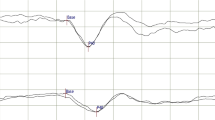Abstract
Brain and spinal cord magnetic resonance imaging (MRI), multimodal evoked potentials (EPs) and cerebrospinal fluid (CSF) analysis were performed in 27 patients with acute myelopathy of unknown aetiology (AMUA), to detect the diagnostic and prognostic values of paraclinical tests at presentation. Spinal cord MRI was abnormal in 56% and brain MRI in 33% of the patients. Visual EPs were abnormal in 7%, median somatosensory EPs in 17%, tibial somatosensory EPs in 56% and motor EPs in 35% of the cases examined. Brain-stem acoustic EPs were normal in all the patients. CSF oligoclonal bands (OBs) were detected in 30% of cases. The patients were divided into subgroups according to the short-term clinical outcome (complete, partial or absent recovery). There were no significant differences among the three groups as regards MRI findings. Patients with complete recovery showed a significantly lower frequency of tibial somatosensory EP and motor EP abnormalities. According to the paraclinical findings at onset and on the basis of a long-term clinical follow-up (mean duration 24 months), 6 patients were diagnosed as having clinically definite multiple sclerosis, while 21 did not develop further neurological disturbances. Only the presence of CSF OBs was significantly more frequent in patients with definite multiple sclerosis. Our study indicates that EPs exploring spinal cord function are more powerful than spinal MRI for predicting the short-term outcome of AMUA, while the combined use of brain MRI and CSF OBs has the highest negative predictive value for the subsequent development of clinically definite multiple sclerosis.
Similar content being viewed by others
References
Arlien-Soborg P, Kjaer L, Praestholm J (1993) Myelography, CT and MRI of the spinal canal in patients with myelopathy: a prospective study. Acta Neurol Scand 87:95–102
Berman M, Feldman S, Alter M, Zilber N, Kahana E (1981) Acute transverse myelitis: incidence and etiologic considerations. Neurology 31:966–971
Boumpas DT, Patronas NJ, Dalakas MC, Hakim CA, Klippel JH, Balow JE (1990) Acute transverse myelitis in systemic lupus erythematosus: magnetic resonance imaging and review of the literature. J Rheumatol 17:89–92
Cantello R, Gianelli M, Civardi C, Mutani R (1993) Magnetic brain stimulation: the silent period after the motor evoked potential. Neurology 42: 1951–1959
Filippi M, Martinelli V, Locatelli T, Medaglini S, Poggi A, Visciani A, Scotti G (1990) Acute- and insidiousonset myelopathy of undetermined aetiology: contribution of paraclinical tests to the diagnosis of multiple sclerosis. J Neurol 237:171–176
Filippi M, Horsfietd MA, Morrissey SP, MacManus DG, Rudge P, McDonald WI, Miller DH (1994) Quantitative brain MRI lesion load predicts the course of clinically isolated syndromes suggestive of multiple sclerosis. Neurology 44:635–641
Ford B, Tampieri D, Francis G (1992) Long-term follow-up of acute partial transverse myelopathy. Neurology 42: 250–252
Hughes GRV (1993) The antiphospholipid syndrome: ten years on. Lancet 342:341–344
Jeffery DR, Mandler RN, Davis IE (1993) Transverse myelitis. Retrospective analysis of 33 cases, with differentiation of cases associated with MS and parainfectious events. Arch Neurol 50: 532–535
Lamartine J (1975) Neurological complications of antirabies vaccination in Sao Paulo, Braz J Neurol Sci 26: 593–598
Lee LH, Hashimoto SA, Hooge JP, Kastrukoff LF, Oger JJF, Li DKB (1991) Magnetic resonance imaging of the head in the diagnosis of multiple sclerosis: a prospective 2-year follow-up with comparison of clinical evaluation, evoked potentials, oligoclonal banding and CT. Neurology 41:657–660
Lipton HL, Teasdall RD (1973) Acute transverse myelopathy in adults. Arch Neurol 28:252–257
Marti-Fàbregas J, Martinez JM, Illa I, Escartin A (1989) Myelopathy of unknown etiology. A clinical follow-up and MRI study of 57 cases. Acta Neurol Scand 80:455–460
Martinelli V, Comi G, Filippi M, Poggi A, Colombo B, Rodegher M, Scotti G, Triulzi F, Canal N (1991) Paraclinical tests in acute-onset optic neuritis: basal data and results of a short follow-up. Acta Neurol Scand 84:231–236
Miller DH, Ormerod IEC, Rudge P, Kendall BE, Moseley IF, McDonald WI (1989) The early risk of multiple sclerosis following isolated acute syndromes of the brainstem and spinal cord. Ann Neurol 26:635–639
Morrissey SP, Miller DH, Kendall BE, Kingsley DPE, Kelly MA, Francis DA, MacManus DG, McDonald WI (1993) The significance of brain magnetic resonance imaging abnormalities at presentation with clinically isolated syndromes suggestive of multiple sclerosis. A 5-year follow-up study. Brain 116:135–146
Poser CM, Paty DW, Scheimberg L, McDonald WI, Davis FA, Ebers GC, Johnson KP, Sibley WA, Silberberg DH, Tourtellotte WW (1983) New diagnostic criteria for multiple sclerosis: guidelines for research protocols. Ann Neurol 13:227–231
Ropper AH, Poskanzer DC (1978) The prognosis of acute and subacute transverse myelopathy based on early signs and symptoms. Ann Neurol 4:51–59
Ropper AH, Miett T, Chiappa KH (1982) Absence of evoked potential abnormalities in acute transverse myelopathy. Neurology 32:80–82
Simeon-Aznar CP, Tolosa-Vilella C, Cuenca-Luque R, Jordana Comajuncosa R, Ordi-Ros J, Bosch-Gil JA (1992) Tranverse myelitis in systemic lupus erythematosus: two cases with magnetic resonance imaging. Br J Rheumatol 31:555–558
Thompson GB (1956) Dissecting aortic aneurysm with infarction of the spinal cord. Brain 79:111–118
Tola MR, Granieri E, Caniatti L, Paolino E, Monetti C, Dovigo L, Scolozzi R, De Bastiani P, Carreras M (1992) Systemic lupus erythematosus presenting with neurological disorders. J Neurol 239:61–64
Van der Eerden HAM, Koetsier JC, Polman CH (1990) Making a diagnosis in patients with an isolated spinal cord syndrome. Acta Neurol Scand 81:205–208
Author information
Authors and Affiliations
Rights and permissions
About this article
Cite this article
Martinelli, V., Comi, G., Rovaris, M. et al. Acute myelopathy of unknown aetiology: a clinical, neurophysiological and MRI study of short-and long-term prognostic factors. J Neurol 242, 497–503 (1995). https://doi.org/10.1007/BF00867419
Received:
Revised:
Accepted:
Issue Date:
DOI: https://doi.org/10.1007/BF00867419



